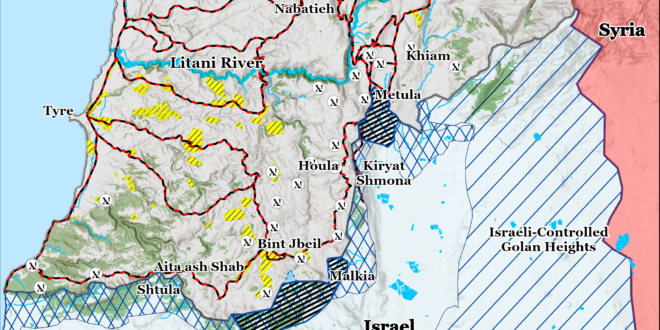The Israel Defense Forces (IDF) has advanced into southern Lebanon along at least two axes. Geolocated imagery shows Israeli forces separately approaching Odaisseh and Maround al Ras.[1] The IDF 36th and 98th divisions participated in these advances and both have elements that fought in the Gaza Strip.[2] The Lebanese Armed Forces claimed that Israeli forces went around 1,300 feet into Lebanon around Odaisseh and Khirbet Yaroun and that the Israeli forces retrograded after a ”short period.”[3] This activity comes after the IDF began the initial phase of its ground operation into southern Lebanon on October 1. This effort—paired with the IDF air campaign—is meant to degrade Lebanese Hezbollah capabilities and destroy much of the military infrastructure that Hezbollah has built in southern Lebanon in violation of UN Security Council Resolution 1701.[4] These military effects are meant, in turn, to achieve the stated Israeli war aim of safely returning displaced civilians to their homes in northern Israel.[5] Thousands of Israeli civilians have fled their homes, as Hezbollah has conducted almost daily attacks into northern Israel since October 2023.[6]
Hezbollah engaged the IDF as it advanced into southern Lebanon. Hezbollah claimed that it engaged Israeli forces in Odaisseh and Maround al Ras in southern Lebanon.[7] Hezbollah also claimed that it detonated improvised explosive devices (IED) targeting Israeli forces near Kfar Kila and Yaroun.[8] The IDF reported that it killed Hezbollah fighters and destroyed military infrastructure in unspecified locations.[9] The IDF also reported that Hezbollah killed eight Israeli soldiers in four separate engagements.[10]
The IDF Arabic-language spokesperson called on civilians to evacuate immediately from 24 towns in southern Lebanon.[11] The spokesperson asked residents to travel north of Awali River, which is 30 miles north of Litani River. The spokesperson separately asked residents to avoid traveling by vehicle from north of Litani River to anywhere south of it.[12]
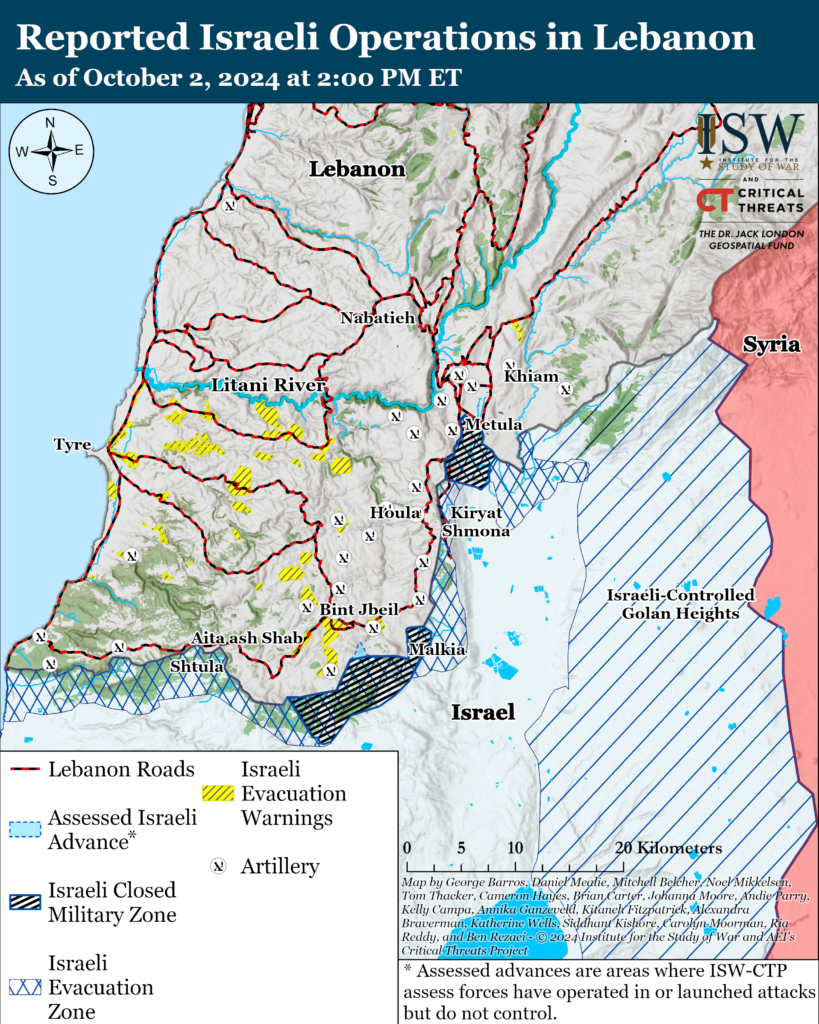
The IDF continued its air campaign targeting Hezbollah capabilities, infrastructure, and leadership. The IDF struck Hezbollah militants as well as observation posts and weapons depots, among other military infrastructure sites, across Lebanon.[13] The IDF reported that it has struck Hezbollah munitions production sites around Beirut in recent days.[14] The IDF also reported that it has destroyed over 150 Hezbollah infrastructure sites in airstrikes over an unspecified period of time[15]
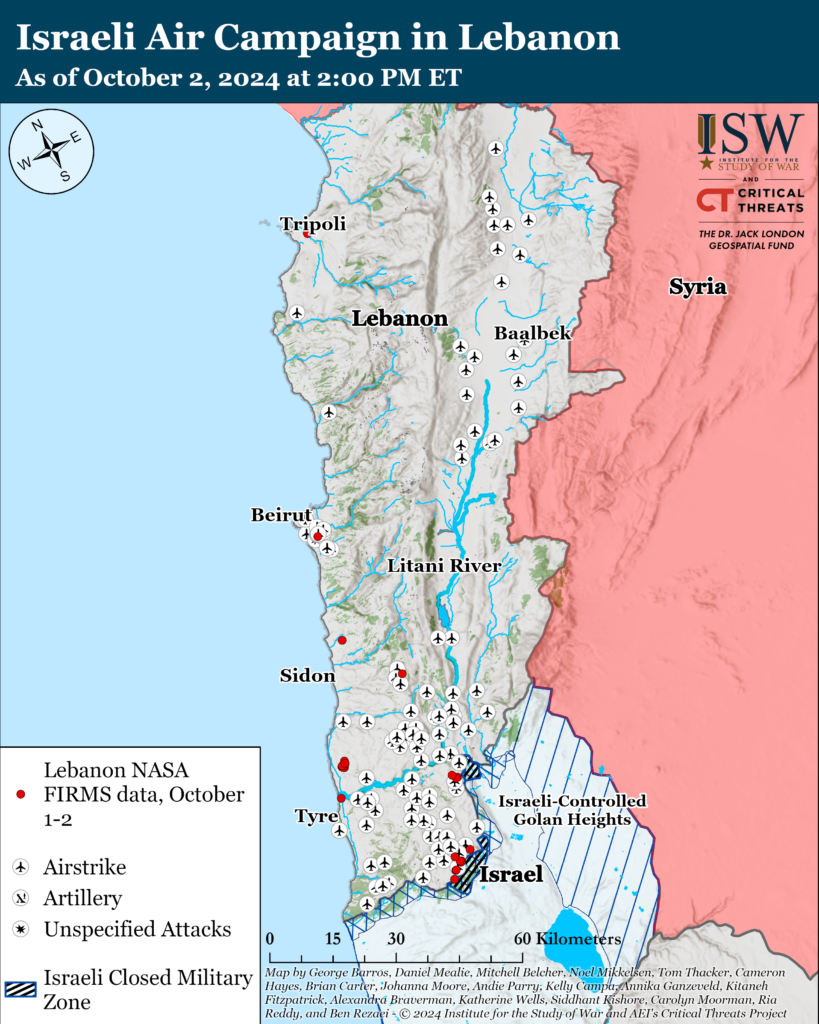
This map illustrates individual Israeli air and artillery strikes based on local Lebanese reporting. This map depicts strikes reported from 2:00pm ET on October 1 to 2:00pm ET on October 2. This map is not exhaustive. CTP-ISW cannot independently verify the locations of Israeli strikes.
Hezbollah has continued its attack campaign targeting civilian and military locations in Israel. Hezbollah conducted a two-wave rocket attack targeting an IDF position in Avivim for the second consecutive day on October 2.[16] The IDF reported that two rockets landed in an open area near Avivim.[17] Hezbollah also claimed that it fired rockets at Haifa in response to Israeli advances into southern Lebanon.[18] Hezbollah has fired rockets at Haifa almost daily since September 21. Hezbollah separately attacked IDF personnel around the Israel-Lebanon border on October 2. Hezbollah fired rockets targeting Israeli troops near Adamit, Avdon, Misgav Am, Shtula, and Yaara
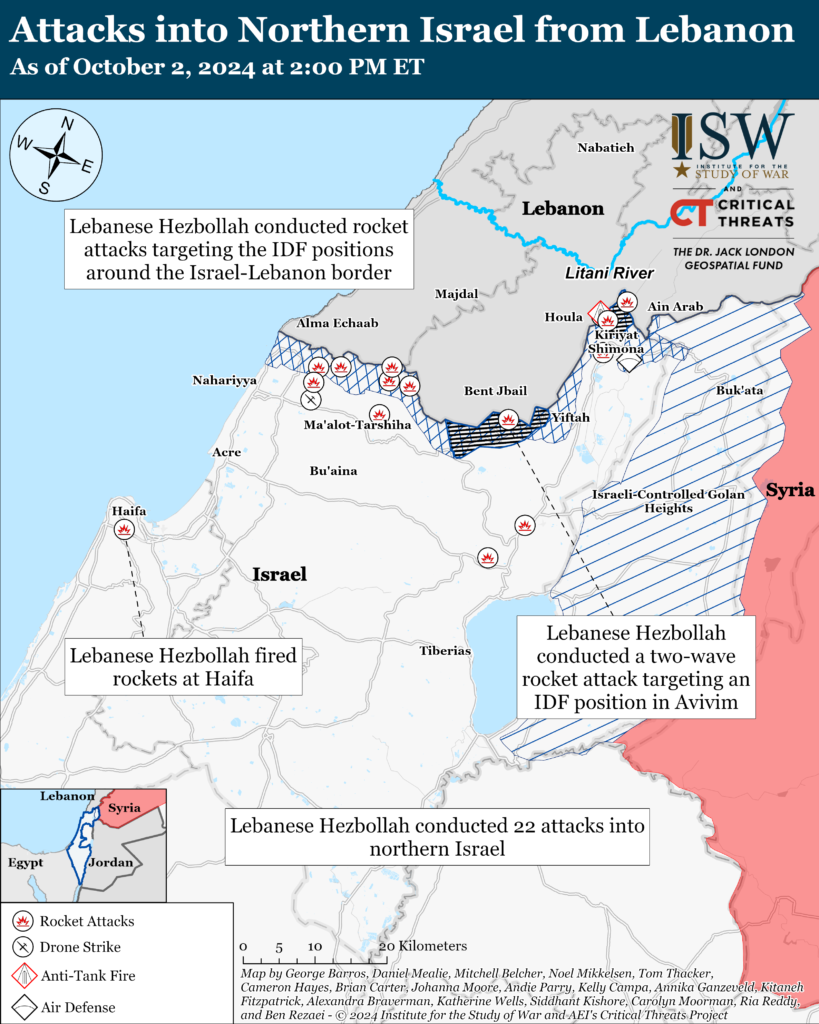
The IDF released new information on Hezbollah planning to launch a ground attack into Israel in the days after Hamas’ attack into Israel in October 2023. Israel military correspondent reported that over 3,000 Iranian-backed fighters deployed to the Israel-Lebanon border after Hamas’ October 7 attack in preparation for their own possible ground attack into Israel.[21] This force included 2,400 militants from Hezbollah‘s Radwan special operations forces and 500 Palestinian Islamic Jihad militants. The correspondent added that these forces were equipped with ”thousands of guns, anti-tank missiles, mines, [and] RPGs.”[22] The forces also had equipment, including aerial photographs, binoculars, night-vision goggles, and protective vests.[23] The correspondent lastly said that the force planned to use explosives to destroy the border walls between Israel and Lebanon and also use tunnels in order to enter Israel.
The Iranian missile attack into Israel on October 1 appears to have been more effective at penetrating Israeli air defenses than the Iranian drone-missile attack in April 2024. This may indicate that Iran is learning how to optimize its strike packages against Western and Israeli air defenses. Though Israel intercepted most of the missiles that Iran launched on October 1, some of the missiles managed to impact. These missiles caused minor damage to dozens of homes north of Tel Aviv, a major road near the Mossad headquarters in Tel Aviv, a school in central Israel, and the IDF Nevatim airbase in the Negev Desert.[24] In contrast, the United States, Israel, and their regional partners intercepted almost all of the drones and missiles that Iran launched in April 2024.[25]
Several factors could have led to the increased damage in the most recent Iranian attack. One factor could be that Iran meaningfully increased its volume of fire, launching 180-200 ballistic missiles compared to the 120 that it launched in April 2024.[26] Iran also refrained from launching slower moving cruise missiles and drones in the April 2024 attack.[27] Former Israeli Missile Defense Organization head Uzi Rubin said that the April 2024 attack was “easier to defend [against]” because the cruise missile and drones gave the IDF “plenty of warning.”[28] The ballistic missiles took about 15 minutes to fly from Iran to Israel.[29] Iran separately appeared to concentrate much of its fire around densely populated central Israel in the most recent attack, whereas Iran exclusively attacked remote areas in April 2024. Israeli air defenses are designed to avoid intercepting projectiles that will land in open areas. But the concentration of fire on central Israel, where there is a high risk of collateral damage, may have been designed to overwhelm Israeli air defenses by saturating the airspace with a large number of projectiles over relatively small and densely populated areas.
Outlets affiliated with the Islamic Revolutionary Guards Corps (IRGC) reported that Iran used a combination of missiles to achieve different effects in the attack.[30] The outlet stated that the liquid-fueled Emad missiles were meant to engage Israeli interceptors, while the more advanced Fattah and Kheybar Shekan missiles were meant to strike precision targets.
Iranian military leaders threatened that they would launch larger attacks on Israel if Israel retaliated for the October 1 missile attack.[31] Armed Forces General Staff Chief Major General Mohammad Bagheri warned that Iran would repeat its October 1 attack with “greater intensity” and target “all [Israeli] infrastructure” if Israel attacks Iranian territory.[32] Artesh Commander Major General Abdol Rahim Mousavi similarly warned that Iran would attack unspecified Israeli infrastructure if Israel retaliates against Iran for the October 1 attack.[33] Mousavi added that future Iranian attacks would be “stronger and multiple times [larger].”[34]
These Iranian threats come amid reports that Israel will conduct a “significant retaliation” against Iran in the coming days.[35] Anonymous Israeli officials told Axios that Israel may target Iranian air defense sites or energy infrastructure or conduct a targeted killing similar to the killing of Hamas Political Bureau Chairman Ismail Haniyeh in Tehran in July 2024.[36] The officials said that the Israeli retaliation will be “much more significant” than the Israeli response to the April 2024 Iranian drone and missile attack.[37] Israel at the time conducted an airstrike targeting an Artesh airbase in Esfahan, Iran, in retaliation.[38] The Israeli officials added that Israel could attack Iranian nuclear facilities if Iran launched another attack.[39]
Adviser to IRGC Commander Major General Hossein Salami, Ebrahim Jabari, claimed on October 2 that Iran conducted a cyber attack targeting Israeli air defense systems at the same as its ballistic missile attack on October 1.[40]
Reuters reported on how deeply Israel has infiltrated the Iranian security establishment and Hezbollah, citing anonymous Iranian sources.[41] The report stated that Iranian Supreme Leader Ali Khamenei offered to relocate Hezbollah Secretary General Hassan Nasrallah to Iran in response to concerns of Israeli infiltration and the possibility that Israel would try to kill Nasrallah. Nasrallah declined the offer, according to the report, and Khamenei sent IRGC Brigadier General Abbas Nilforoushan to Beirut to persuade Nasrallah. Nilforoushan died in the Israeli airstrike that killed Nasrallah in Beirut. The airstrike follows several other Israeli operations killing high-profile officials in the Axis of Resistance, such as Mohammad Reza Zahedi, Fuad Shukr, and Ismail Haniyeh. Reuters reported that the killings—coupled with Israel detonating thousands of Hezbollah pagers and personal radios—has stoked mistrust and paranoia among Iranian and Hezbollah leaders, including Khamenei. Iran, according to Reuters, launched investigating possible Israeli agents in the Iranian security apparatus, focusing on individuals traveling or with family abroad. Reuters also reported that Iran has arrested several individuals on suspicion that they helped Israel kill Nasrallah.
The Islamic Resistance in Iraq—a coalition of Iranian-backed Iraqi militias—claimed three drone attacks targeting three unspecified locations in northern Israel on October 2.[42]
Iranian-backed Iraqi militias threatened on October 1 to attack US forces in the Middle East if the United States attacks or helps Israel attack Iran in retaliation for the October 1 Iranian missile attack. Kataib Hezbollah threatened to attack US forces and interests in Iraq and across the region if the United States participates in “any hostile action” against Iran or if Israel uses Iraqi airspace to attack Iran.[43] Harakat Hezbollah al Nujaba similarly threatened to attack US forces if the United States or Israel attack Iran.[44] Harakat Hezbollah al Nujaba separately criticized Jordan for helping Israel intercept Iranian ballistic missiles.[45]
Houthi spokesperson Yahya Sarea claimed that the Houthis launched three Quds-5 cruise missiles at unspecified locations in Israel on October 2.[46] Sarea claimed that the missiles hit their targets and added that the Houthis are ready to join any combined military operations against Israel. CTP-ISW cannot verify whether these attacks occurred.
Hamas claimed responsibility for the terror attack in Jaffa, south of Tel Aviv, on October 1.[47] Hamas claimed that two fighters managed to infiltrate into Israeli territory from the West Bank to conduct the attack. The two Hamas fighters reportedly stabbed and killed an Israeli security officer and seized his firearm.[48] The two attackers then shot and killed eight civilians in Jaffa and wounded 16 others before Israeli forces killed both attackers.[49] The IDF identified the two Hamas fighters as residents of Hebron in the West Bank and identified their homes for demolition.[50] The IDF also detained and interrogated several “suspects,” who were likely assisted the two Hamas fighters in the attack. [51]
Jaish al Adl—a Baloch Salafi-jihadi group—has increased its rate of attacks targeting security forces in southeastern Iran in recent days. This uptick coincides with the two-year anniversary of “Bloody Friday,” when Iranian security forces brutally suppressed protests in Zahedan, Sistan and Balochistan Province.[52] Jaish al Adl has claimed the following attacks.
September 28
An attack killing the deputy police chief of the Law Enforcement Command (LEC) in Sib and Suran.[53]
An attack targeting two LEC officers at a police station in Zahedan.[54]
September 29
A small arms and IED attack targeting two patrol vehicles in Rask.[55]
An attack targeting an LEC officer in Khash.[56]
An attack targeting an LEC base at Iranshahr.[57]
October 1
An attack on the “Festival of Affections” ceremony at a school in Bent, killing a local IRGC commander and the head of the city council.[58]
An attack targeting an IRGC Intelligence Organization vehicle, killing two agents in Rask.[59]
An attack targeting a security patrol, killing two officers in Khash.[60]
This activity is part of a general increase in anti-regime militancy in southeastern Iran since December 2023.[61] Jaish al Adl has conducted numerous attacks targeting Iranian security forces in this time, at times demonstrating unprecedented coordination and organization.[62] Iranian Interior Minister Eskandar Momeni ordered Deputy Interior Minister for Security and Police Affairs Brigadier General Ali Akbar Pour Jamshidian and the Sistan and Baluchistan governor to conduct an investigation into the recent attacks.[63] Iranian leaders could interpret some of this activity through the lens of their fight against the United States and Israel, as they have long accused both countries of stoking anti-regime militancy in Iran.
Key Takeaways:
Lebanon: The IDF has advanced into southern Lebanon along two axes. Hezbollah engaged the IDF as it advanced, killing at least eight Israeli soldiers. The IDF called on civilians across southern Lebanon to evacuate immediately and move northward.
Iran: The recent Iranian missile attack on Israel appears to have been more effective at penetrating Israeli air defenses than the Iranian drone-missile attack in April 2024. This may indicate that Iran is learning how to optimize its attacks against Western and Israeli defenses.
Iran: Israel will reportedly conduct a “significant retaliation” against Iran in the coming days. Iranian military leaders threatened that they would respond by conducting an even greater attack on Israel.
Iran: Reuters reported on how deeply Israel has infiltrated the Iranian security establishment and Hezbollah. Israeli operations, including the killing of senior Axis of Resistance officials, has stoked mistrust and paranoia among Iranian and Hezbollah leaders.
Iraq: Iranian-backed Iraqi militias threatened to attack US forces if the United States supports an Israeli retaliation against Iran. Militia officials also criticized Jordan for purportedly helping Israel intercept Iranian ballistic missiles.
Iranian internal security: There has been a significant uptick in anti-regime militancy in southeastern Iran in recent days. This coincides with the two-year anniversary of “Blood Friday,” when Iranian security forces brutally suppressed protesters in southeastern Iran.
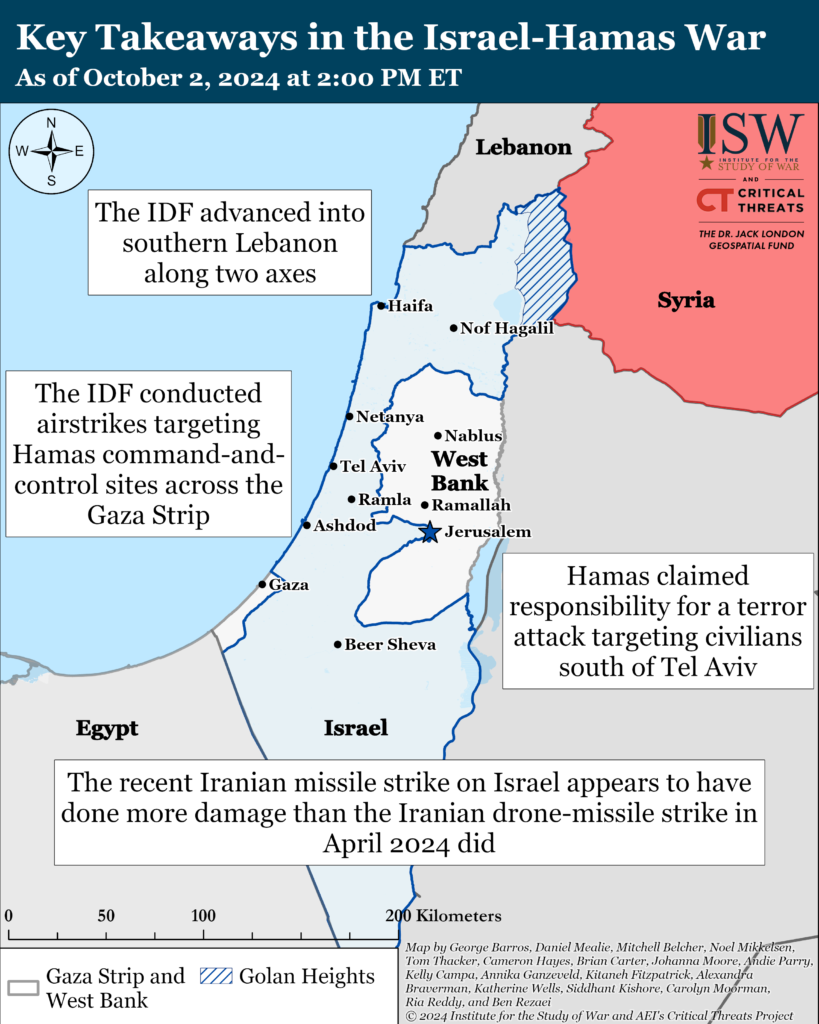
Gaza Strip
Axis of Resistance objectives:
Erode the will of the Israeli political establishment and public to sustain clearing operations in the Gaza Strip
Reestablish Hamas as the governing authority in the Gaza Strip
The IDF Air Force conducted airstrikes targeting Hamas command-and-control sites across the Gaza strip on October 1 and 2. Three of the sites were in central Gaza Strip.[64] The IDF reported that two of the three were based in the Brig High School and Nuseirat Girls school and that Hamas fighters used the sites to plan and conduct attacks targeting Israeli forces in the Gaza Strip and into Israeli territory.[65] The IDF added that it took steps to minimize casualties in these two airstrikes. The third site in the central Gaza Strip was in a tent in Nuseirat.[66] The IDF stated that this site posed an immediate threat to Israeli forces in the area.[67] The IDF separately conducted airstrikes targeting two Hamas command-and-control sites in the northern Gaza Strip.[68] The IDF reported that the two sites were based in the former Muscat and Rimal schools and that Hamas used these sites to attack Israeli forces.[69]
The IDF fired small arms targeting “dozens of suspects” in central Gaza Strip on October 1.[70] The IDF stated that these individuals posed a threat to Israeli forces in the area.
Hamas fired mortars and rockets targeting Israeli forces around the Netzarim Corridor on October 1.[71]
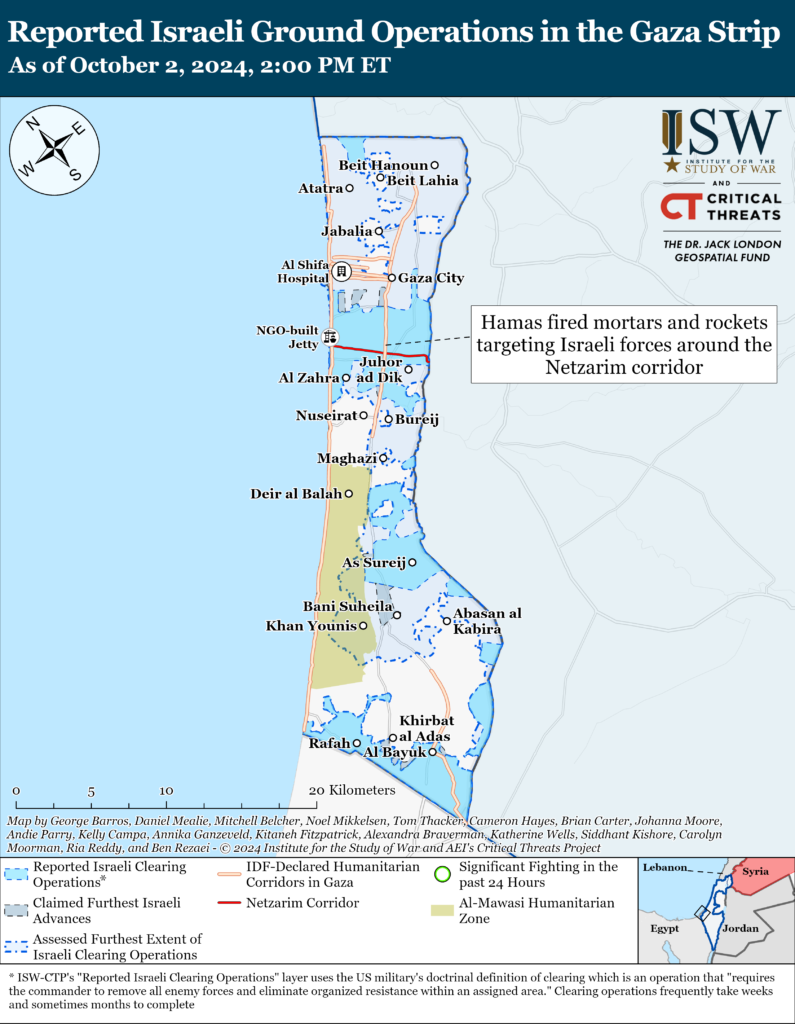

West Bank
Axis of Resistance objectives:
Establish the West Bank as a viable front against Israel
Hamas claimed responsibility for the terror attack in Jaffa, south of Tel Aviv, on Octob
add note
tweet
er 1.[72] Hamas claimed that two fighters managed to infiltrate into Israeli territory from the West Bank to conduct the attack. The two Hamas fighters reportedly stabbed and killed an Israeli security officer and seized his firearm.[73] The two attackers then shot and killed eight civilians in Jaffa and wounded 16 others before Israeli forces killed both attackers.[74] The IDF identified the two Hamas fighters as residents of Hebron in the West Bank and identified their homes for demolition.[75] The IDF also detained and interrogated several “suspects,” who were likely assisted the two Hamas fighters in the attack. [76]
The IDF conducted overnight raids across the West Bank and detained 16 wanted individuals.[77] The IDF confiscated firearms and materials used to manufacture improvised explosive devices during the raids.[78]
Southern Lebanon and Golan Heights
Axis of Resistance objectives:
Deter Israel from conducting a ground operation into Lebanon
Prepare for an expanded and protracted conflict with Israel in the near term
Expel the United States from Syria
Lebanese Hezbollah conducted at least 22 attacks into northern Israel since CTP-ISW’s last data cutoff on October 1.[79] See the topline section for more information.
Iran and the Axis of Resistance
US Central Command (CENTCOM) destroyed six Houthi drones in Houthi-controlled areas of Yemen on September 30.[80] CENTCOM determined that the drones presented an imminent threat to US and coalition forces and merchant vessels in the area.
Iranian President Masoud Pezeshkian traveled to Doha, Qatar, on October 2 for an official visit, during which he will meet with Qatari Emir Sheikh Tamim bin Hamad Al Thani and participate in the Asian Cooperation Dialogue Forum.[81]
Iranian First Vice President Mohammad Reza Aref headed a trade delegation to a Eurasian Economic Union (EAEU) summit in Yerevan, Armenia,on 1. Aref underlined [82]Iranian prioritization of Eurasian economic cooperation and trade opportunities in his EAEU address. Aref referenced the International North-South Transit Corridor (INSTC), which Iran, Russia, and I[83]ia established in 2000. Iranian Trade Devlopment Organization Director Mohammad Ali Dehghan Dehnavi established a working group to improve Iranian-Armenian commerce in a meeting with the Armenian Deputy Econoy Miniser Nare[84] Hovakimyan on Oct Iranian Industry, es, and Trade Minister Mohammad Atabek proposed expanding Iranian-Armenian mining cooperation to Armenia Territorial Administration and Infrastructure Mi[85]str Gel Sanosyan. Atabe also invited Sanosyan to the Mining and Mineral Industries Exhibition in Iran in November 2024. Russian[86]Belarussian, Kazakhstani, Kyrgyzstani, and Uzbekistani delegations attended the EAEU summit too.[87]
Iranian Foreign Affairs Minister Abbas Araghchi appointed Esmail Baghaei as the new spokesperson of the Foreign Affairs Ministry on October 2.[88] Baghaei served as the assistant to the foreign affairs minister and the Iranian ambassador and permanent representative to the UN Office in Geneva from 2018 to 2021. Baghaei also headed the ministry’s Legal Affairs Department from 2011 to 2015 and represented Iran in the UN Legal Committee from 2006 to 2010.[89]
 Eurasia Press & News
Eurasia Press & News
